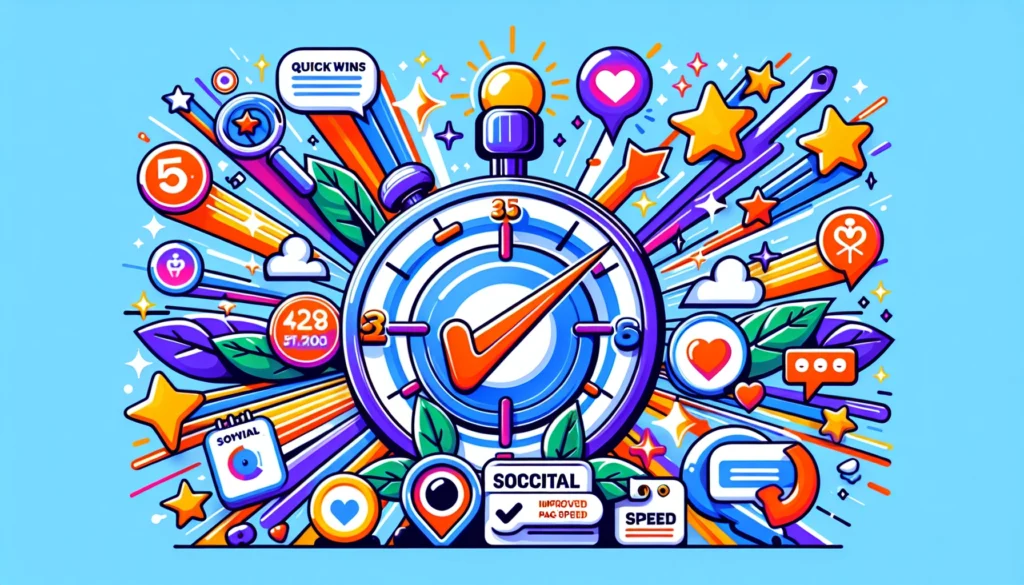Table of Contents[Hide][Show]
Want to increase the number of visitors who become customers on your website? Conversion rate optimization (CRO) can help. The conversion rate optimization process is a structured approach involving multiple frameworks and steps to enhance website performance. In this article, we’ll share the top 10 CRO tips for 2024, covering everything from landing page optimization to advanced techniques like personalization and dynamic content. Get ready to transform your site’s performance and boost your conversion rates and overall digital marketing results.
Understanding Conversion Rate Optimization

Conversion Rate Optimization (CRO) is the practice of enhancing website performance to convert visitors into customers. Essentially, I view CRO as a core part of your marketing strategy aimed at increasing the percentage of an audience that performs a specific action, such as making a purchase or signing up for a newsletter. Enhancing specific website elements and overall user experience, CRO helps businesses maximize their potential and generate revenue.
The primary purpose of conversion rate optimization is to guide visitors smoothly through the decision-making process, improve user interactions, and encourage them to take the desired actions. Effective CRO campaigns boost conversion rates, enhance user experiences, build trust with visitors, and improve overall website performance. Understanding CRO means knowing what conversions are, how to calculate them, and what constitutes a good conversion rate.
What is a conversion?
A conversion is defined as an action taken by a visitor that fulfills a specific website goal, such as making a purchase, signing up for a newsletter, or clicking on a link. Conversions are typically categorized into macro and micro conversions. Macro conversions are primary actions that lead to major outcomes, like completing a purchase. In contrast, micro conversions are smaller, supportive actions that guide users towards the macro goals, such as adding a product to a cart or submitting a form.
Defining macro and micro conversion goals is crucial for tailoring measurable strategies aligned with business objectives. The conversion funnel, a series of pages leading to a conversion goal, effectively guides users through the decision-making process.
Examples of conversions can vary widely, from click-throughs on social media ads to signing up for newsletters or completing contact forms.
How to calculate conversion rate
Total Number of Visitors / Total Conversions = X
X * 100 = Conversion Rate (as a percentage)
The site’s conversion rate is a crucial metric for evaluating the effectiveness of a website in turning visitors into paying customers. It is calculated by dividing the number of conversions by the total number of visitors and multiplying by 100. For instance, if your site had 1,000 visitors and 50 made a purchase, your conversion rate would be 5%.
Accurate conversion tracking is crucial for understanding your website’s performance and making data-driven decisions. This requires using reliable marketing analytics tools with specific conversion tracking capabilities.
Consistently monitoring and analyzing conversion data helps identify areas for improvement and implement conversion rate optimization strategies to increase conversions.
What is a good conversion rate?
Determining what constitutes a reasonable conversion rate can be challenging, as it varies significantly across industries. On average conversion rate, e-commerce websites see rates ranging from 2.5% to 3%. However, benchmarks can differ; for example, the conversion rate for online shoppers in Great Britain is over 4%, while in the United States, a good e-commerce conversion rate is around 2.3%.
For industries like legal services in the B2B sector, a high conversion rate is regarded as anything over 7%. Achieving a high conversion rate indicates that a website is well-optimized for its target audience. Mobile optimization is also crucial, as over 58% of global web traffic comes from mobile devices. Ensuring your website is mobile-friendly can significantly influence your conversion rates.
Knowing industry benchmarks is essential for setting realistic conversion goals and measuring your website’s performance against competitors. Continuously optimizing your website for desktop and mobile users helps achieve and maintain a reasonable conversion rate through search engine optimization.
Key Elements of Effective Conversion Rate Optimization

Effective Conversion Rate Optimization (CRO) involves several key elements that enhance user experience and drive conversions. These core components include:
Conversion research
User experience design
Website persuasion techniques
A/B testing and personalization
By focusing on these areas, businesses can create a more engaging and efficient website that encourages visitors to take desired actions.
Enhancing user experience design improves usability, keeps visitors on the site longer, and significantly raises conversion rates. Addressing areas for CRO, such as landing pages, call-to-actions (CTAs), and navigation, can substantially impact your website’s overall performance.
These fundamental elements contribute significantly to successful CRO strategies.
Landing page optimization
Landing pages are critical in defining a website’s usability and success, as they attract and retain visitors. The primary purpose of a landing page is to guide traffic toward a specific call-to-action conversion objective, whether it’s making a purchase, filling out a form, or signing up for a newsletter. A well-optimized landing page can boost conversion rates by creating a solid first impression and influencing user perception.
Creating an effective landing page involves defining desired visitor actions and crafting a compelling value proposition. Key strategies include using a clear and concise headline, prioritizing critical information like the value proposition and CTA at the top of the page, and maintaining a clean and uncluttered design. Businesses with over 40 landing pages generate 12 times more leads, highlighting the importance of optimized content.
Iterative testing and refining of landing pages can significantly improve their effectiveness. This includes modifying pricing intervals, describing product features, and incorporating gamification elements to enhance user engagement and drive conversions. Effective pop-ups can increase conversion rates by demanding user attention, responding to behavior, and creating urgency.
Compelling call-to-action (CTA)
A call to action (CTA) instructs the audience about what to do next, commonly in the form of a button or link. Strong CTAs can significantly increase the number of leads generated by clearly guiding users toward the desired action. Effective CTAs should be simple, direct, and strategically placed to ensure users understand the intended action.
Positioning CTAs above the fold enhances visibility and immediate user engagement. Additionally, using urgency and emotional triggers in the design and wording of CTAs can significantly enhance their effectiveness. Personalized CTAs lead to a 202% higher conversion rate than generic prompts, demonstrating the power of tailored messaging.
Streamlined navigation
Easy navigation is critical for user engagement, ensuring visitors can quickly find what they need without frustration. Key features that enhance navigation include a streamlined menu, intuitive search functionality, and minimizing the number of clicks required to reach key information. A well-structured site layout can significantly enhance user experience and reduce bounce rates. Additionally, a well-structured site layout can improve the website’s conversion rate by facilitating navigation and reducing bounce rates.
Optimizing navigation involves designing a user-friendly interface that guides visitors seamlessly through the website. This includes ensuring that design elements fit seamlessly into the page layout and creating a positive user experience. By simplifying the onboarding process and enhancing website usability, businesses can increase conversion rates and encourage more users to take desired actions.
Benefits of Implementing CRO

Implementing effective Conversion Rate Optimization (CRO) strategies offers numerous benefits for businesses. By maximizing the value of existing visitors, CRO can significantly reduce customer acquisition costs and enhance resource utilization. Highly qualified leads, increased revenue, and lower acquisition costs are some of the primary outcomes of successful CRO efforts.
CRO also provides valuable insights into user behavior, helping businesses tailor their offerings according to customer needs. Understanding visitor preferences and pain points allows businesses to optimize website functionality and improve the overall sales process. These improvements lead to better sales outcomes and a higher return on investment.
Cost efficiency
CRO significantly enhances businesses’ cost efficiency by optimizing conversion rates without necessitating additional traffic. Improving conversion rates reduces cost per acquisition and minimizes extensive advertising investments. This leads to better resource utilization and more effective digital advertising strategies.
Maximizing the value derived from existing traffic is a key aspect of CRO, as it reduces the need for additional marketing efforts. Optimizing user experience and addressing conversion barriers allows businesses to achieve more conversions without increasing traffic, leading to cost savings and higher profitability.
Enhanced customer insights
CRO efforts facilitate a deeper understanding of customer pain points, allowing businesses to address them effectively. Leveraging data and analytics helps companies tailor their offerings to better meet customer needs and preferences. Combining quantitative and qualitative data provides a comprehensive understanding of visitor behavior, leading to more informed decisions and targeted improvements.
Failing to utilize data and analytics can result in missed opportunities to enhance conversion rates. Machine learning algorithms can quickly analyze customer feedback, helping companies identify their strengths and weaknesses. This continuous feedback loop ensures businesses stay aligned with customer expectations and drive higher conversions.
Increased sales and revenue
Conversion Rate Optimization (CRO) improves conversion rates, leading to increased sales and revenue. For example, a mere 3% improvement in conversion rate can result in significant additional revenue for high-volume companies. Regular engagement with leads and personalization strategies can enhance customer loyalty and increase revenue.
Successful CRO efforts have demonstrated remarkable results. For instance, Flos USA achieved a 125% increase in checkout conversions after implementing CRO enhancements, resulting in an 18X return on investment. Similarly, abandoned cart emails generate a high engagement rate, leading to approximately 50% of recipients making a purchase.
Steps in the CRO Process
The Conversion Rate Optimization (CRO) process consists of several essential steps that work together to systematically improve conversion rates. These steps include:
Research
Hypothesis development
Testing and experimentation
Analysis and iteration
Each step plays a crucial role in identifying areas for improvement, validating hypotheses, and refining website elements to enhance user interactions and drive conversions.
Effective CRO relies on a combination of quantitative and qualitative data to inform optimization efforts.
Tools that help analyze user behavior and identify barriers to conversions include:
Web analytics platforms
User feedback tools
Heatmaps
Session recordings
By integrating data from diverse tools, businesses can gain granular behavioral insights essential for making informed CRO decisions.
Research phase
Before:
The research phase is the first step in the CRO process and involves analyzing quantitative data to understand user actions and identify areas for improvement. Metrics like bounce rates and page visits can be benchmarks for conversion optimization. Additionally, clicks on links and form submissions also provide valuable insights. Combining these quantitative metrics with qualitative insights, such as user feedback and behavior analytics, is crucial for understanding user behavior.
After:
The research phase is the first step in the CRO process and involves analyzing quantitative data to understand user actions and identify areas for improvement. Key metrics include:
Bounce rates
Page visits
Clicks on links
Form submissions
Combining these quantitative metrics with qualitative insights, such as user feedback and behavior analytics, is crucial for understanding user behavior.
Outlining website goals before starting CRO facilitates the generation of testing ideas or hypotheses. Tools like Google Analytics 4 and VWO Insights provide valuable quantitative data crucial for the research stage. Additionally, behavior analytics tools like heatmaps and session recordings can help uncover pain points in the conversion process.
Hypothesis development
Creating a clear hypothesis is essential for guiding CRO efforts. A well-structured hypothesis involves stating a specific change, the anticipated outcome, and the reasoning behind it. This hypothesis is a foundation for the execution strategy, guiding design and development teams in their optimization efforts.
By defining a hypothesis, businesses can focus their CRO activities on measurable and actionable goals.
Testing and experimentation
Testing and experimentation are crucial components of the CRO process. A/B testing, also known as split testing, is a method of optimization that compares two or more versions of content to determine which performs better in terms of conversion. Conducting A/B tests helps determine what works and what doesn’t, guiding necessary website adjustments. It’s important to focus each A/B test on one variable to keep results clear and actionable.
Before conducting an A/B test, ensure that the website receives enough traffic for statistically significant results. Let the experiment run until it reaches statistical significance to provide reliable conclusions. Ending an A/B test too early may lead to premature conclusions on effectiveness, hindering improvement. Common types of tests used in CRO include A/B testing, split testing, and multivariate testing.
Analyzing performance through tests helps find the best variations for ongoing optimization. If an A/B test fails, analyze what the losing variation lacked and why it wasn’t appealing to users. Iterate on successful changes based on insights gained through testing to ensure ongoing improvement.
Analysis and iteration
The final step in the CRO process is analysis and iteration. Identifying drop-off points through scroll map reports can help optimize key elements like CTAs. Evaluate the effects on metrics and group analysis by age or devices to gain comprehensive insights. Successful iterations rely on analyzing winning and losing tests to extract valuable learnings.
Optimization ideas in CRO must be backed by visitor data to ensure effective changes. After reviewing goals and gains, it is essential to invest in conversion optimization tools to support further iterations. Combining quantitative and qualitative data helps inform modifications and enhance website performance.
Structured CRO can effectively transform a website into a tool that supports growth and success.
Quick Wins for Boosting Conversions

Sometimes, small changes can lead to substantial improvements in conversion rates. Quick wins for boosting conversions often involve practical tips and tactics that can be implemented quickly and yield immediate results. These strategies include simplifying forms, improving page speed, and leveraging social proof to build visitor trust.
Visitors often abandon conversions due to the complexity of the process, highlighting the need for simplicity. Businesses can significantly improve their conversion rates by focusing on quick adjustments that enhance user experience and reduce friction.
Simplify forms
Forms play a significant role in a company’s sales funnel as they directly impact conversion rates. Streamlining forms can lead to fewer barriers and enhanced user experience, encouraging more visitors to complete them. When optimizing forms, it’s crucial to balance lead quality with the volume of leads to ensure effective data collection.
To simplify forms, consider reducing the number of fields, using clear and concise labels, and implementing user-friendly validation messages. These changes can make the form completion process more straightforward and less intimidating for visitors, ultimately leading to higher conversion rates.
Improve page speed
Page speed is a critical factor in user satisfaction and conversion rates. Faster website loading times significantly improve user satisfaction and conversion rates. For instance, a one-second delay can reduce conversions by 7% and lead to the loss of 11% of potential customers. Websites loading within one second convert 3 times higher than those loading within five seconds.
To improve loading speed, remove non-essential elements like large images, compress image file sizes, and use tools like Google’s PageSpeed Insights to assess and refine your website’s performance. Ensuring your mobile site loads within two seconds can lead to a 15% higher conversion rate than average.
Businesses can also enhance user experience and achieve higher conversion rates by optimizing page speed.
Leverage social proof
Social proof involves showcasing previous customer usage or reviews to encourage others to take action. Implementing social media proof strategies can lead to a direct increase in conversion rates and overall business success. Showcasing positive customer experiences can greatly enhance trust and increase conversions.
Utilizing testimonials and reviews effectively can significantly strengthen a brand’s credibility in the eyes of potential customers. By incorporating social proof elements on landing pages, businesses can build trust with visitors and improve conversion rates.
Advanced CRO Techniques
Advanced CRO techniques are essential for businesses looking to stay competitive and effectively engage their customers. These strategies include personalization, behavioral targeting, and dynamic content. Implementing these techniques can improve user experiences and increase conversion rates, resulting in higher revenue.
Emerging technologies like AI and AR are set to redefine strategies in conversion rate optimization. Machine learning algorithms can automatically optimize web pages based on user behavior, enhancing conversion rates. Let’s explore these advanced techniques in more detail.
Personalization
Effective personalization relies on understanding customer needs through historical and real-time data while balancing machine learning with a human touch. Automated, contextually relevant messaging improves customer engagement and conversion rates. Dynamic content adjusts in real-time to user interactions, enabling personalized experiences that can lead to higher conversion rates.
Personalization significantly enhances user engagement by tailoring experiences to individual preferences. Businesses can create more meaningful interactions and drive higher conversions by delivering relevant content based on user behavior.
Behavioral targeting
Behavioral targeting involves tracking and analyzing user interactions on a website to understand what makes users click, bounce, and buy. Tools for visitor behavior research, such as heatmaps, session recordings, form analytics, and surveys, provide valuable insights into user behavior.
Heatmaps can indicate hotspots and areas of low engagement, providing visual insights into user interaction. Session recordings allow observers to watch individual user journeys and identify confusion or abandonment.
By addressing the desires and pain points of the target audience, businesses can strategically place relevant CTAs in popular blog posts to enhance content engagement and drive conversions.
Dynamic content
Dynamic content refers to web page elements that change based on user behavior, preferences, and demographics, enhancing user experience and engagement. Personalization in dynamic and interactive content allows businesses to deliver tailored messages and offers to users, significantly improving engagement and conversion rates.
Behavioral targeting within dynamic content utilizes data from user interactions to customize experiences precisely, making the content even more relevant to individual users. By integrating personalization and behavioral targeting, businesses can increase the relevance of their offerings, thereby enhancing the likelihood of conversions.
Tools for Effective CRO
To implement effective CRO strategies, businesses need the right tools to analyze user behavior, identify barriers, and conduct experiments. Key tools for CRO include Google Analytics, VWO (Visual Website Optimizer), and Hotjar. These tools provide valuable insights and help businesses tailor their content and marketing strategies based on user interactions.
Selecting the right CRO tool is essential for increasing conversion rates and enhancing user experience. Evaluating the pros and cons of different tools based on their effectiveness and efficiency can help businesses make informed decisions.
Let’s take a closer look at these tools.
Google Analytics
Google Analytics includes features like goal tracking, funnel visualization, and segmentation, which are crucial for conversion rate optimization. By tracking user interactions such as session duration, pages viewed, and bounce rate, Google Analytics provides insights that help businesses identify improvement areas and measure the impact of changes made to the website.
Analyzing website visitors’ behavior and conversions through Google Analytics allows businesses to make informed decisions to enhance website performance and increase conversion rates. This powerful tool is essential for understanding how users interact with your website and where improvements can be made.
VWO (Visual Website Optimizer)
Visual Website Optimizer is a versatile testing platform that supports various testing methods, including A/B testing, multivariate testing, and behavior analytics. VWO provides a centralized platform for managing experimentation programs, making it an integrated tool for conversion rate optimization.
Integrating VWO with Google Analytics 4 maximizes insights from A/B testing. VWO also offers pre-experiment tools for setting duration and sample size and calculating statistical significance, ensuring that experiments are conducted effectively. By creating personalized user experiences (color schemes, content, and more), VWO enhances engagement and conversion rates.
Hotjar
Hotjar is a powerful tool that helps gather insights into user behavior to enhance website performance. It offers features like customer feedback analysis and targeted on-site feedback widgets, allowing businesses to understand user perspectives and identify areas for improvement.
Hotjar provides heat maps and session recordings to visualize user engagement and gather feedback to improve website performance. Using Hotjar’s analytical tools helps in identifying areas for improvement, leading to enhanced conversions and overall site efficiency.
Case Studies: Successful CRO Implementations

Observing successful brands in CRO provides valuable insights and lessons for crafting effective strategies. Case studies demonstrate the practical application of CRO tools and techniques, showcasing how businesses have significantly improved conversion rates.
Let’s look at two notable examples: Bear Mattress and Flos USA.
Bear Mattress
Bear Mattress aimed to increase revenue by optimizing its cross-sell flow through targeted CRO initiatives. Their efforts led to a 24.18% rise in purchase success rates and a 16.21% boost in income. Focusing on customer purchasing behavior and refining website elements helped Bear Mattress significantly improve overall revenue and customer satisfaction.
Flos USA
Flos USA undertook strategic website improvements aimed at enhancing user experience. These enhancements included optimizing the checkout process to reduce friction and streamline user interactions.
As a result, Flos USA observed marked improvements in their checkout conversions, achieving an impressive 18-fold return on investment.
Common CRO Mistakes to Avoid
Misconceptions and challenges in adopting CRO strategies are common, often leading to ineffective outcomes. One major mistake is relying on opinion rather than statistical data for CRO decision-making. Additionally, running too many tests simultaneously can dilute results, while conducting minor tests may yield little impact on conversion rates.
Other common pitfalls include overusing image sliders without A/B testing and using multiple pop-ups that can annoy and confuse users. To avoid these mistakes, businesses should focus on well-crafted, SEO-optimized content that aligns with business goals and conduct larger tests for more noticeable impacts on conversion rates.
Ignoring mobile optimization
Ignoring mobile optimization is a significant mistake in CRO, especially considering the growing number of mobile users. Marketers should adopt a mobile-first approach in their web content to cater to this audience. Simplifying navigation, enlarging buttons, and reducing text can enhance the mobile visitor experience.
Google’s Lighthouse is a useful tool to check a website’s responsiveness across various devices. By ensuring that your website is mobile-friendly, you can improve user experience and increase conversion rates from mobile visitors.
Overlooking data quality
Data quality is pivotal for effective CRO as it influences decision-making and optimization strategies. Poor data quality can lead to misguided strategies, resulting in a loss of potential conversions. Regular audits of data quality are essential to maintain reliable analytics and optimize CRO efforts.
Reliable and accurate data is necessary for effective CRO, allowing businesses to make informed decisions that drive growth. By prioritizing high-quality data, companies can ensure that their optimization strategies are based on accurate and actionable insights.
Future Trends in CRO
Embracing future trends in CRO is critical for long-term growth, as it allows businesses to adapt to changing consumer behaviors and technological advancements. Key strategies for staying ahead in CRO include integrating technology, adopting customer-centric approaches, and maintaining a proactive mindset towards emerging trends.
Emerging technologies like AI, machine learning, AR, and VR are set to redefine CRO strategies. These advancements enable real-time personalization and predictive analytics, enhancing user experiences and maximizing conversion potential.
AI and machine learning
AI and machine learning are transforming conversion rate optimization by enabling real-time personalization and predictive analytics. For instance, AI in VWO generates testing ideas and summarizes survey responses in minutes, optimizing testing processes and accelerating insights. Integrating AI and machine learning in CRO signifies a shift towards data-driven strategies that enhance user experiences and maximize conversion potential.
Industries such as the medical and technology sectors are prominently impacted by AI advancements, leveraging data analysis to enhance customer engagement. By embracing these technologies, businesses can stay ahead of the curve and implement more effective CRO strategies.
Augmented reality (AR) and virtual reality (VR)
Integrating AR and VR into CRO strategies enhances the online shopping experience and offers a competitive edge. AR and VR create personalized experiences that significantly impact purchasing decisions. For example, AR allows customers to visualize products in their own environment, while VR offers immersive experiences that can drive engagement and conversions.
As these technologies become more accessible, businesses can leverage AR and VR to provide unique, interactive experiences that differentiate them from competitors. By incorporating AR and VR into their CRO efforts, companies can enhance user engagement, improve conversion rates, and stay at the forefront of digital innovation.
Conclusion
In conclusion, Conversion Rate Optimization (CRO) is an essential strategy for businesses looking to maximize their online potential and drive more revenue. By understanding the fundamentals of CRO, implementing key elements such as landing page optimization, compelling CTAs, and streamlined navigation, and leveraging advanced techniques like personalization and dynamic content, businesses can significantly improve their conversion rates and overall website performance.
As we move into 2024, staying ahead of the curve with emerging trends like AI, machine learning, AR, and VR is crucial for long-term growth. By embracing these technologies and continuously refining their CRO strategies, businesses can enhance user experiences, drive higher conversions, and achieve sustained success in the digital marketplace.
Frequently Asked Questions
What is Conversion Rate Optimization (CRO)?
Conversion Rate Optimization (CRO) focuses on improving website elements and user experience to effectively convert visitors into customers. By strategically enhancing these aspects, businesses can drive better performance and higher conversion rates.
How do you calculate the conversion rate?
To calculate the conversion rate, divide the number of conversions by the total number of visitors, then multiply the result by 100. This will give you the percentage of visitors that converted.
What are some quick wins for boosting conversions?
To boost conversions quickly, simplify your forms, enhance page speed, and utilize social proof to establish trust with your visitors. These changes can lead to immediate improvements in your conversion rates.
How can AI and machine learning improve CRO?
AI and machine learning significantly enhance conversion rate optimization (CRO) by enabling real-time personalization and predictive analytics, which improve user experiences and identify effective strategies swiftly. This leads to increased conversion potential through optimized testing and insights derived from user feedback.
What role does A/B testing play in CRO?
A/B testing, also known as split testing, is crucial in CRO as it allows businesses to compare two or more variations of a webpage to determine which one performs better in terms of conversions. This helps in making data-driven decisions to optimize website elements effectively.
How important is page speed for conversion rates?
Page speed is vital for conversion rates as faster loading times significantly improve user satisfaction and reduce bounce rates. A one-second delay in page load time can lead to a 7% reduction in conversions, making it essential to optimize page speed for better performance.

 AI Video Generator Tools: Create Stunning Videos Instantly in 2025
AI Video Generator Tools: Create Stunning Videos Instantly in 2025